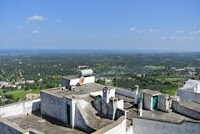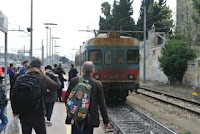When we travel, we like to rent an apartment and
actually live there for long enough that you get to know the place. We like to
be able to shop for food and actually cook the food that we can buy locally. We
have done pretty well so far in Spain, Portugal, Hungary and England, but Italy
has proved to be a bit more of a problem.
 |
| Our Kitchen |
The
first problem was locating food to cook. I asked Leo, the very helpful manager
here where I could find a grocery store. He sent me around the corner, through another
set of big green doors into another courtyard to a local store. It looked like
grandma had set up a little convenience store in her living room. She had a
cooler with some cheese and salami, and a fridge with a few cans of coke and
Italian soda. On shelves around the room was a sorry collection of canned
goods. No fresh vegetables, nor meat, and I did not want to check the “Best
Before” on those cans. I asked Leo for a “Big” grocery store and he sent me
outside the old city to a “Supermarcedo”. This was an actual supermarket, but
was smaller than most of our corner stores. It had a little of everything, but
the emphasis would be on little. The vegetable section was a couple of shelves about
18” wide; a few tomatoes, three onions, garlic and two dozen eggs. It took me
ten minutes just to find the black pepper conveniently located beside the beer
and wine, which I was also looking for. Not a good start. I was starting to
feel a bit concerned with our ability to cook Italian . . . .
 |
| This is not Italian . . . |
Back
to Leo to try to explain that I wanted a REALLY BIG store. He patiently got out
a map and showed me how to get to two other stores quite a bit further afield.
Determined to succeed in this cooking thing, we set out and located these two
stores, both good large well stocked supermarkets, but I am not sure what Leo
would think as he entered one of our Sobey’s or SuperStore outlets, and I am
sure he would be struck dumb if he saw the Auchan's
(My Friend Gordon will know
what I mean) I bought groceries in when in China.
Then
after all that we found an actual city market right outside the city gate that
sells a wonderful selection of meat and vegetables. I think the problem is that
guests here just do not cook, electing instead to eat out in the many excellent
local restaurants.
 |
| Now this looks Italian . . . . |
The
next problem is the language. Southern Italy is probably as bad as anywhere we have
visited for the lack of English. Many people here just do not speak or
understand English. I realize that this is their country and it is me that
should be speaking their language, but I have never had a problem getting along
with just English. What is Lactose Free in Italian? Is that Sheep Cheese or Cow
cheese? What on earth is that vegetable?
We
are however cooking Italian, but we are often making it up as we go. Regis
wanted to make Ravioli, so she went out and bought what she thought was a sheet
of fresh pasta. A translation of the package back at the apartment revealed it
was some kind of pastry. A quick change of plans; lets make a calzone sort of
thing. Onions, garlic, and local sausage simmered in red wine, then mixed with
peppers, tomato, and zucchini, tossed with tomato sauce, topped with real
buffalo mozzarella, seasoned with fresh oregano and finally wrapped in the
mystery pastry produced a really amazing dinner. It was so good it may even go
in my cookbook.





































